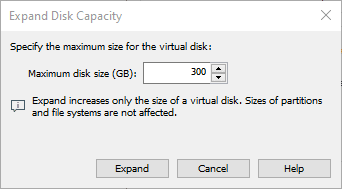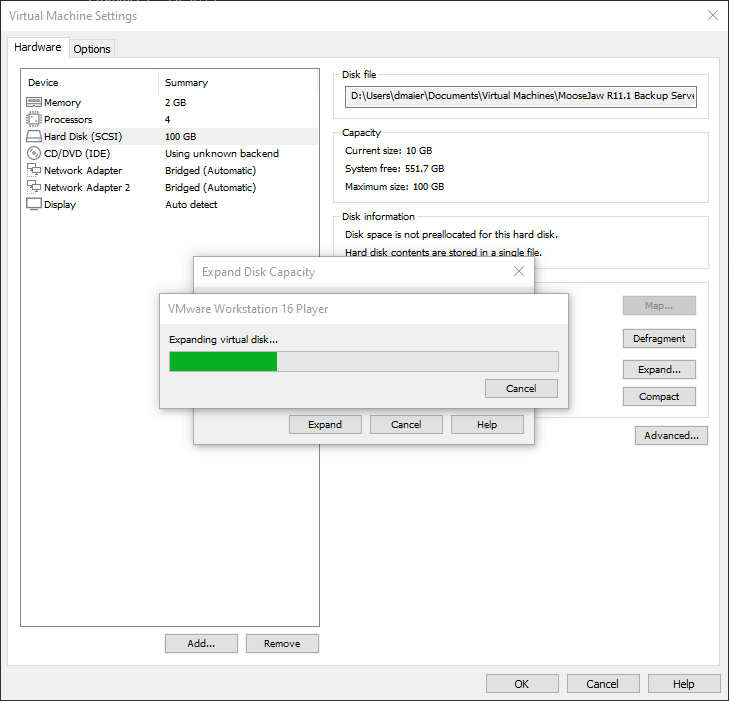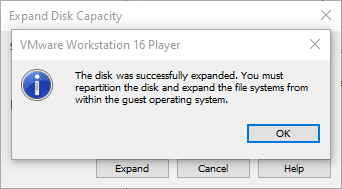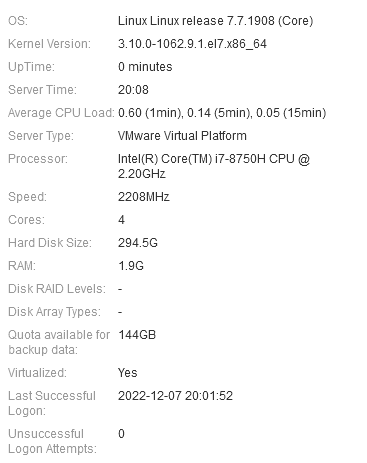#!/bin/bash
##########
# Script to resize a LVM Partition after extending the underlying disk device. Can be used on physical or virtual machines alike.
# Tested with CentOS6, RHEL6, CentOS7, RHEL7. This script is only intended for MBR partitioned disks and not for GPT.
#
# The script will first resize the partition by changing the partition end sector of the selected partition, and then after a reboot resize the filesystem.
# By default it rescans the SCSI bus to check a change in disk size if the disk was hot-extended, which is easy with VMs, and only then proceeds.
# If the extended disk size is recognized by the OS already, you can force resizing with the -f flag.
#
# Github: [URL unfurl="true"]https://github.com/alpacacode/Homebrewn-Scripts[/URL]
########
usage() {
echo "Usage:
$0 [-p <LVM physical volume>] [-l <LVM logical volume>] [-f]
Options:
-p physical LVM volume device to extend (check pvdisplay)
-l logical LVM volume to extend (check lvdisplay)
-f force extending without a disk rescan. Use this if the OS has detected the enlarged disk already, otherwise we first check whether the underlying disk is larger after a SCSI rescan
Example:
./lvmresize.sh -p /dev/sda2 -l /dev/VolGroup/lv_root -f
It is highly recommended you backup the boot sector of your disk before as a safety measure with something like the following:
# dd if=/dev/sda of=sda_mbr_backup.mbr bs=512 count=1
# sfdisk -d /dev/sda > sda_mbr_backup.bak
You can restore the partition table then like this:
# dd if=sda_mbr_backup.mbr of=/dev/sda bs=512 count=1
# sfdisk /dev/sda < sda_mbr_backup.bak --force" 1>&2
exit 1
}
extenddisk_parted() {
# Use parted because fdisk behavior can vary between OSes and scripting fdisk is non-deterministic.
# Using parted resizepart would be easer, but RHEL/CentOS6 parted doesn't support resizepart
echo -e "\nThis will now extend partition number $partitionnum on disk $disk using start sector $startsector.\nWARNING: Make sure you backup your boot sector prior to this."
read -r -p "Are you sure? [y/N] " response
response=${response,,} # tolower
if [[ $response =~ ^(yes|y)$ ]]
then
echo -e "\n+++Current partition layout of $disk:+++"
parted $disk --script unit s print
if [ $logical == 1 ]
then
parted $disk --script rm $ext_partitionnum
parted $disk --script "mkpart extended ${ext_startsector}s -1s"
parted $disk --script "set $ext_partitionnum lba off"
parted $disk --script "mkpart logical ext2 ${startsector}s -1s"
else
parted $disk --script rm $partitionnum
parted $disk --script "mkpart primary ext2 ${startsector}s -1s"
fi
parted $disk --script set $partitionnum lvm on
echo -e "\n\n+++New partition layout of $disk:+++"
parted $disk --script unit s print
# The 2nd script to expand the filesystem will be automatically executed on the next reboot.
echo "#!/bin/bash
#Extend Physical Volume first
pvresize $p
#Extend LVM, using 100% of the free allocation units and resize filesystem
lvextend --extents +100%FREE $l --resizefs
chmod -x \$0" > /root/fsresize.sh
chmod +x /root/fsresize.sh
# Use a temporary systemd service or a rc.local script for extending the filesystem during next reboot, depending on what the OS is running.
if(pidof systemd)
then
resizefs_systemd
else
resizefs_rclocal
fi
echo -e "Done. The system will reboot automatically in 15 seconds and resize the filesystem during reboot.\n"
sleep 15
# Reboot is necessary in most cases for the kernel to read the new partition table.
reboot
else
echo -e "Aborted by user.\n"
exit 1
fi
}
resizefs_rclocal() {
# Resize the filesystem using a script in rc.local if the OS run with sysvinit.
echo "#Cleanup rc.local again
sed -i /etc/rc.local -e '/\/root\/fsresize\.sh/d' --follow-symlinks
sed -i /etc/rc.local -re 's/^#(exit 0)$/\1/' --follow-symlinks" >> /root/fsresize.sh
sed -i /etc/rc.local -re 's/^(exit 0)$/#\1/' --follow-symlinks
echo "/root/fsresize.sh" >> /etc/rc.local
}
resizefs_systemd() {
# Resize the filesystem using a script called by a temporary systemd service file if the OS runs with systemd.
echo "#Cleanup systemd autostart script again.
systemctl disable fsresize.service
rm -f /etc/systemd/system/fsresize.service" >> /root/fsresize.sh
echo "[Unit]
Description=Filesystem resize script for LVM volume $l
[Service]
ExecStart=/root/fsresize.sh
[Install]
WantedBy=multi-user.target" > /etc/systemd/system/fsresize.service
systemctl enable fsresize.service
}
# Get options passed to the script.
while getopts ":p:l:f" o; do
case "${o}" in
p)
p=${OPTARG}
;;
l)
l=${OPTARG}
;;
f)
f=1
;;
*)
usage
;;
esac
done
shift $((OPTIND-1))
if [ -z "${p}" ] || [ -z "${l}" ]
then
usage
fi
command -v fdisk >/dev/null 2>&1 && command -v parted >/dev/null 2>&1 && command -v pvresize >/dev/null 2>&1 || {
echo -e "Error: Some of the required utilities (fdisk, parted, lvm tools etc) don't seem to be installed on this system. Aborting.\n" >&2
exit 1
}
# Check if a valid LVM physical volume was supplied by verifying the pvdisplay exit code ($?).
pvdisplay $p > /dev/null
if [ $? != 0 ] || ( ! (file $p | grep -q "block special"))
then
echo -e "Error: $p does not look like a block device or LVM physical volume. Aborting.\n"
usage
fi
# Check if a valid LVM logical volume was supplied by verifying the lvdisplay exit code ($?).
lvdisplay $l > /dev/null
if [ $? != 0 ]
then
echo -e "Error: $l does not look like a LVM logical volume. Aborting.\n"
usage
fi
# Fill variables for later use.
disk=$(echo $p | rev | cut -c 2- | rev) # /dev/sda
diskshort=$(echo $disk | grep -Po '[^\/]+$') # sda
partitionnum=$(echo $p | grep -Po '\d$') # 2
startsector=$(fdisk -u -l $disk | grep $p | awk '{print $2}')
# Detect LVM on logical/extended partition
layout=$(parted $disk --script unit s print)
if grep -Pq "^\s$partitionnum\s+.+?logical.+$" <<< "$layout"
then
echo -e "Detected LVM residing on a logical partition.\n"
logical=1
ext_partitionnum=$(parted $disk --script unit s print | grep extended | grep -Po '^\s\d\s' | tr -d ' ')
ext_startsector=$(parted $disk --script unit s print | grep extended | awk '{print $2}' | tr -d 's')
else
logical=0
fi
parted $disk --script unit s print | if ! grep -Pq "^\s$partitionnum\s+.+?[^,]+?lvm$"
then
echo -e "Error: $p seems to have some flags other than the lvm flag set. Other flags are not supported."
usage
fi
if ! (fdisk -u -l $disk | grep $disk | tail -1 | grep $p | grep -q "Linux LVM")
then
echo -e "Error: $p is not the last LVM volume on disk $disk. Cannot expand.\n"
usage
fi
if [ "$f" != 1 ]
then
oldsize=$(cat /sys/block/${diskshort}/size)
# Rescan the SCSI bus to detect the grown disk.
ls /sys/class/scsi_device/*/device/rescan | while read path; do echo 1 > $path; done
ls /sys/class/scsi_host/host*/scan | while read path; do echo "- - -" > $path; done
newsize=$(cat /sys/block/${diskshort}/size)
# Check if the disk is larger now and proceed with the partition expansion if it is.
if [ $oldsize -lt $newsize ]
then
echo -e "Underlying disk $disk is larger now.\n"
extenddisk_parted
else
echo -e "Disk Size not changed after rescan, already rescanned previously? Force extension with -f. Quitting.\n"
fi
# When -f (force) flag is set, proceed to extend the disk without checking if it has grown.
else
extenddisk_parted
fi







